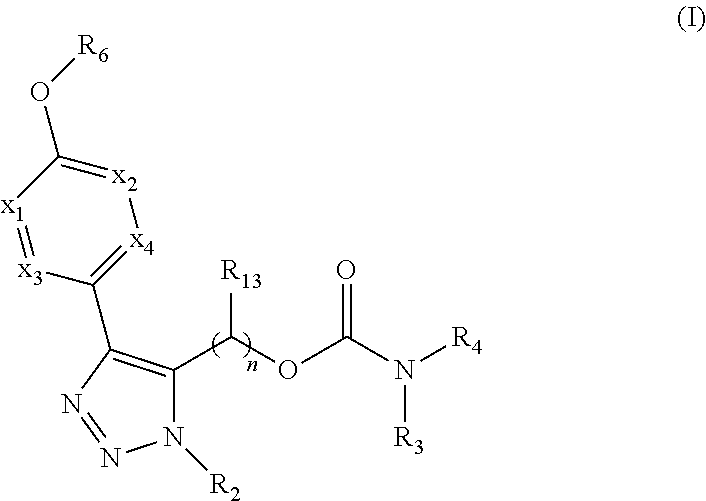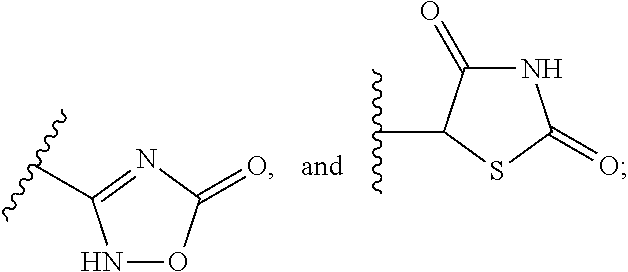Carbamoyloxymethyl triazole cyclohexyl acids as LPA antagonists
a technology of carbamoyloxymethyl triazole and cyclohexyl acids, which is applied in the direction of drug compositions, immunological disorders, metabolism disorders, etc., and can solve problems such as end-organ failur
- Summary
- Abstract
- Description
- Claims
- Application Information
AI Technical Summary
Benefits of technology
Problems solved by technology
Method used
Image
Examples
example 1
[0857]To a stirred solution of 1G (4.6 mg, 9 μmol) in THF (0.5 mL), MeOH (0.1 mL) and water (0.1 mL) at rt was added aq LiOH.H2O (0.023 mL of a 2.0 M solution, 0.045 mmol). The reaction mixture was stirred at 50° C. for 2 h, after which LC-MS showed that all starting material had been consumed. The mixture was acidified to pH=˜1 by dropwise addition of 1M aq. HCl. The mixture was extracted with EtOAc (3×15 mL); the combined organic extracts were concentrated in vacuo. The residue was purified by preparative HPLC (PHENOMENEX®, Axia 5μ C18 30×100 mm column; detection at 220 nm; flow rate=40 mL / min; continuous gradient from 0% B to 100% B over 10 min+2 min hold time at 100% B, where A=90:10:0.1 H2O:MeOH:TFA and B=90:10:0.1 MeOH:H2O:TFA) (to give the title compound as an oil (3.2 mg, 75%). LCMS, [M+H]+=472.3. 1H NMR (500 MHz, DMSO-d6) δ 7.84 (d, J=8.2 Hz, 1H), 7.49 (d, J=8.5 Hz, 1H), 5.64 (br. s., 2H), 4.79 (br. s., 1H), 4.10 (s, 3H), 2.66 (br. s., 4H), 2.42 (s, 3H), 2.10-1.31 (m, 17H)....
example 2
[0871]To a solution of 2F (786 mg, 1.53 mmol) in THF (3 mL) and MeOH (3 mL) added aq. LiOH (3.06 mL of a 2N solution, 6.12 mmol). The reaction mixture was stirred at rt overnight, after which the pH was adjusted to ˜5 and water (10 mL) was added. The mixture was extracted with EtOAc (3×30 mL), washed with water (30 mL) and brine (30 mL), dried (MgSO4) and concentrated in vacuo. The resulting solid was dissolved in 3 mL of EtOAc and allowed to stand overnight to give the title compound as a white crystalline solid (600 mg, 83%). LCMS, [M+H]+=458.2. 1H NMR (500 MHz, CD3CN) δ 8.34 (d, J=2.5 Hz, 1H), 8.08-8.00 (m, 1H), 7.45 (dd, J=8.8, 2.8 Hz, 1H), 5.66 (s, 2H), 4.88-4.73 (m, 1H), 4.11 (s, 3H), 2.87-2.77 (m, 1H), 2.72 (br. s., 3H), 2.10-2.01 (m, 1H), 1.92-1.80 (m, 3H), 1.79-1.57 (m, 9H), 1.56-1.43 (m, 4H). HPLC-1: RT=7.99 min, purity=100%; HPLC-2: RT=7.81 min, purity=100%. hLPA1 IC50=19 nM.
Example 3
(1S,3S)-3-((6-(5-((((2-cyclopropylethyl)(methyl)carbamoyl)oxy)methyl)-1-methyl-1H-1,2,3-t...
example 3
[0879]To a stirred solution of 3B (5 mg, 10 μmol) in THF (1.5 mL), MeOH (0.10 mL) and water (0.15 mL) at rt was added aq. LiOH (0.015 mL of a 2 M solution, 0.030 mmol). The reaction mixture was stirred at 50° C. for 1 h, then was cooled to rt. The mixture was acidified to pH 2.3 by dropwise addition of 1M aq. HCl, then was concentrated in vacuo. The residue was purified by preparative HPLC (PHENOMENEX®, Axia 5μ C18 30×100 mm column; detection at 220 nm; flow rate=40 mL / min; continuous gradient from 0% B to 100% B over 10 min+2 min hold time at 100% B, where A=90:10:0.1 H2O:MeOH:TFA and B=90:10:0.1 MeOH:H2O:TFA) (to give the title compound as an oil (4.2 mg, 92%). 1H NMR (500 MHz, DMSO-δ6) δ 8.13 (br. s., 1H), 7.78 (d, J=8.2 Hz, 1H), 7.33 (d, J=6.4 Hz, 1H), 5.48-5.30 (m, 2H), 4.57 (br. s., 1H), 3.89 (br. s., 3H), 3.09-2.88 (m, 2H), 2.56 (d, J=16.8 Hz, 4H), 2.46 (br. s., 1H), 1.80-1.53 (m, 5H), 1.51-1.25 (m, 5H), 1.20-0.93 (m, 4H). LCMS, [M+H]+=458.4. HPLC-4: RT=1.42 min, purity=100%....
PUM
 Login to View More
Login to View More Abstract
Description
Claims
Application Information
 Login to View More
Login to View More - R&D
- Intellectual Property
- Life Sciences
- Materials
- Tech Scout
- Unparalleled Data Quality
- Higher Quality Content
- 60% Fewer Hallucinations
Browse by: Latest US Patents, China's latest patents, Technical Efficacy Thesaurus, Application Domain, Technology Topic, Popular Technical Reports.
© 2025 PatSnap. All rights reserved.Legal|Privacy policy|Modern Slavery Act Transparency Statement|Sitemap|About US| Contact US: help@patsnap.com



